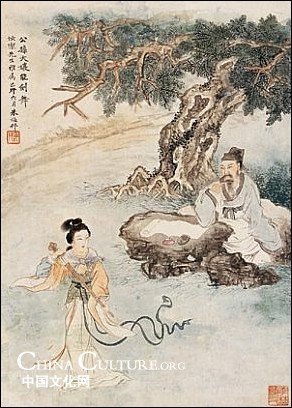As a traditional form of martial art, swordplay has a very long history in China and enjoys immense popularity among the Chinese people. Created earlier than most other ancient weapons, the sword is reputed as the "king of weapons."
In China the earliest swords appeared in the Bronze Age (1711-256BC) and were known as qingtong (bronze) swords. A sword of this kind was made of an alloy of bronze and tin. According to Kaogongji, a book on industrial technology written in the Spring and Autumn Period (770-476BC), a qingtong sword in those days was made up of two parts of tin and three parts of other metals, which made it a powerful weapon. The tin content in the qingtong sword has now been determined to be 13 per cent by modern methods of analysis.
The qingtong sword consists of a blade and a hilt. Along the centre line on the blade is the "ridge" which tapers off to the edges at an angle of about 30 degrees. The handle is either round or oblate in shape. Some of the swords have a hand guard between the blade and the hilt. The length of a qingtong sword varies between a dozen centimeters and a meter or so.

Originally a popular weapon carried about by people for self-defence, the sword was used for military purposes during the Spring and Autumn and the Warring States periods (770-221BC), particularly in some states to the south of the Yangtze, where roads were too narrow in the water-logged regions to permit the use of chariots and long weapons in warfare, and where infantry troops armed with swords proved highly mobile in hand-to-hand fighting.
Down through the ages up to the Yuan Dynasty (1206-1368), practitioners of martial arts all wore swords either for self-defence or for fitness exercises and everyone kept his own sword with great jealousy. Even scholars were fond of wearing swords and they wrote a lot of poems and songs in praise of the weapon. A sword would be the last thing to be relinquished by an impoverished scholar.
Roughly speaking, swordplay consists of such basic skills as the slash, parry, strike, thrust, prick, press and cut. A performer has to pay attention to achieving coordination between the movements of the body and those of the sword, and to guiding the sword with the mind. In ancient times, anyone who was proficient in swordplay would enjoy the respect of society. In ancient literary works, stories about the heroic deeds of people adept in swordsmanship were legion. Various styles of swordplay were developed through the centuries, the most popular being the Tianshan, Wudang and Dharma styles.

After the Western Han Dynasty (201BC-25AD), as a result of the development in smelting technology, bronze swords were replaced by those made of iron. Swords made of steel with high or medium carbon content began to appear, but these did not exit in vast numbers until after the period of the Three Kingdoms (AD220-280).
With the passage of time the value of swords in fighting and self-defence gradually diminished but the art of swordplay continued to improve as a form of health-oriented exercise. Today it is not only widely practised in China, but is gaining increasing favor among wushu lovers in many other countries and regions as well.










